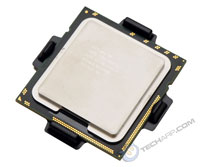Intel Turbo Boost Performance Advantage Revealed
The Intel Core i7 and the Intel Core i5 are Intel's new desktop processors based on the Nehalem microarchitecture, which evolved from the Core microarchitecture that powered the highly successful Intel Core 2 line of microprocessors. Like its predecessors, the new Core i7 and Core i5 processors are manufactured using Intel's high-k (hafnium) dielectric and metal gate technology. However, that is where the similarity ends.
Unlike the Core 2 processors, the new Core i7 and Core i5 processors have a monolithic design. That means the entire quad-core processor is fabricated on a single die. The quad-core version of the Core 2 processor, on the other hand, combines two dual-core dies in a multi-chip package (MCP). The newer Clarksdale core (powering some Core i5 processors) also uses the latest 32 nm process technology. Finally, the Core i7 and Core i5 processors feature a slew of new technologies :
- an integrated DDR3 memory controller
- a three-tier cache design
- QuickPath Interconnect (or Direct Media Interface for some Core i5 processors)
- Intel Turbo Mode technology (now renamed Intel Turbo Boost)
This article will focus on the mysterious Intel Turbo Boost Technology. It has been bandied about by Intel as a nifty way to improve the Core i7 and Core i5's performance with older applications that cannot fully utilize its four processing cores, but what exactly is it?
What Is Turbo Boost?
Multiple processing cores greatly increase a processor's performance. However, the sad fact is that many applications and games are not designed to support more than a single processing core, much less 2, 4 or even 8 cores. Unless specifically designed to be multi-threaded, these software will only make use of a single processor core, even if your processor has many more processor cores to spare.
This is a big problem for modern multi-core processors as it squanders most of the processor's performance - it essentially works like a single-core processor. If most of your software are single-threaded, then there is very little reason for you to upgrade to a multi-core processor. You would not be going any faster with the other processing cores just idling away.
This problem became even more of an issue when quad-core processors became common with the introduction of the Intel Core 2 Quad processor and the new Intel Core i7 and Core i5 processors. Even software that were multi-threaded in nature were mostly optimized for dual-core processors. This made the quad-core processors pointless in all but a few select applications.
To address this issue, Intel introduced the Turbo Boost Technology in all Nehalem-based processors (e.g. Intel Core i7 and Core i5 processors). Despite the fancy name, this is really nothing more than a dynamic overclocking feature. What it does is automatically overclock the processor by 1-2 speed bins (of 133 MHz).
Originally conceived to provide a performance boost for single-threaded applications so that the Intel Core i7/i5 processors will not look like pointless upgrades from the Intel Core 2 family of processors, Intel eventually enabled overclocking for all four cores. So the Intel Turbo Boost Technology is no longer about improving the quad-core processor's single-threaded performance. It has now become a general overclocking feature.
All Nehalem-based processors have a minimum upper limit of one speed bin (+133 MHz). Even if all four cores are active, they would be overclocked by at least 133 MHz. For example, a Intel Core i7-965 Extreme Edition processor that officially has a clock speed of 3.2 GHz would actually be running at a minimum of 3.33 GHz. While this may seem like a free upgrade (which it is, in a way), it is also a disingenuous way to make the Nehalem processors seem faster than other processors on a clock-to-clock basis.
Support Tech ARP!
Help support our work by visiting our sponsors, participate in the Tech ARP Forums, or even donate to our fund. Any help you can render is greatly appreciated!
Page |
Topic |
|
1 |
• Intel Turbo Boost Technology Revealed |
|
2 |
||
3 |
||
4 |
||
5 |
||
6 |
||
7 |
||
8 |
||
9 |
||
10 |







 Add to Reddit
Add to Reddit

